|
Best Lightweight
|
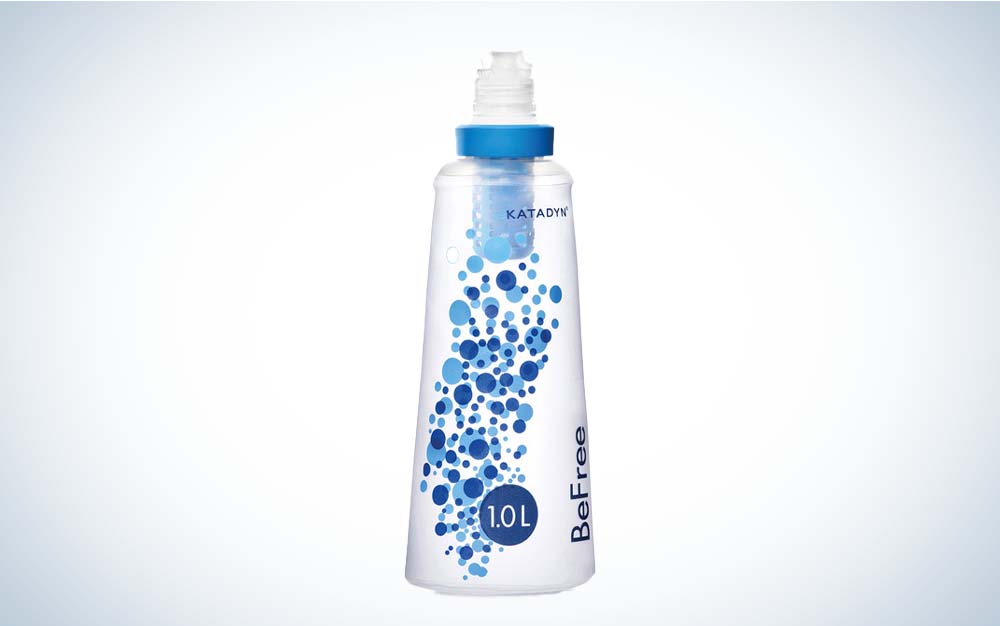
|
BeFree
|
Check Price
|
LEARN MORE
|
Summary
Fastest flow in our test.
|
|
Best Virus Protection
|
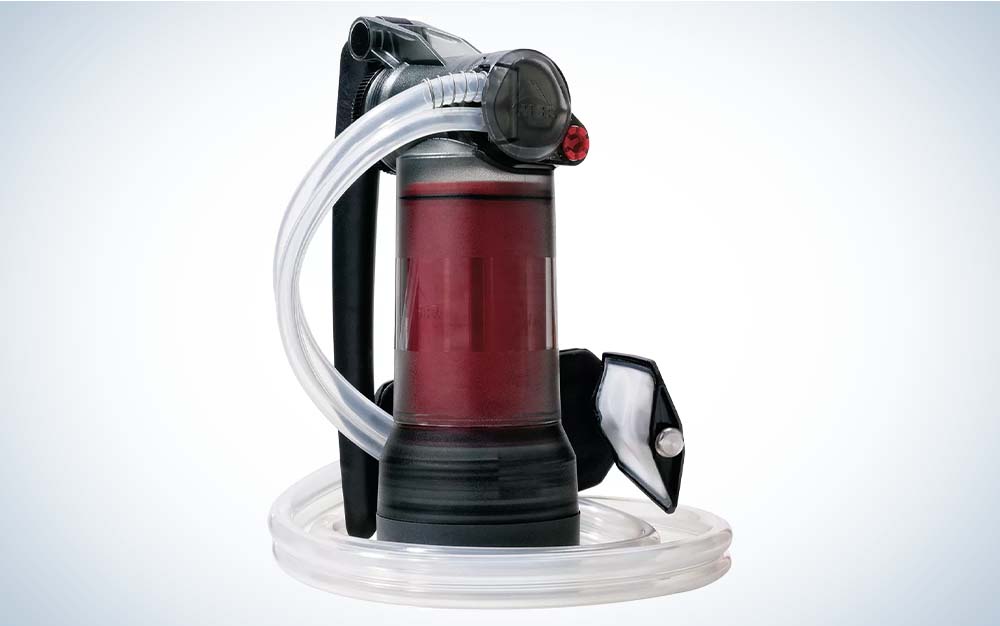
|
MSR Guardian
|
Check Price
|
LEARN MORE
|
Summary
Fast filtration and effective against viruses.
|
|
Best for Groups
|
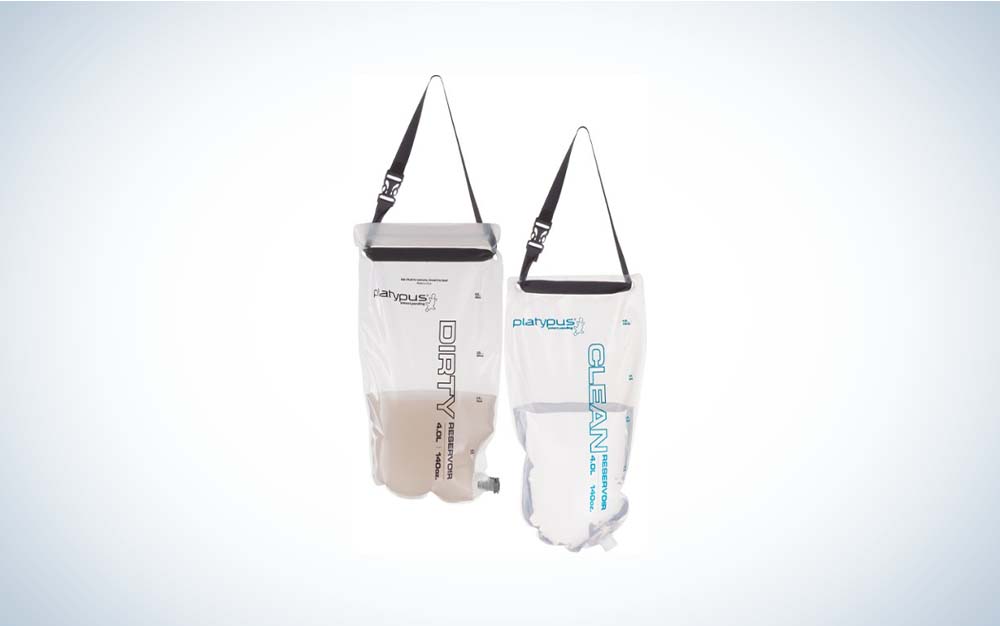
|
Platypus GravityWorks
|
Check Price
|
LEARN MORE
|
Summary
Large and quick enough for big camping groups.
|
Imagine this: you’re in the backcountry, nearly out of liquids on a scorcher of a day, when you hit the first water source you’ve seen for hours. You sit down, pull out your bladder and your pump, and drop the intake tube into the water. But when you go to pump, the pressure goes slack. Or the nozzle jams, barely a drop coming out no matter how much you squeeze. Chances are, if you’ve spent enough time in the backcountry, you don’t have to imagine this scenario: It’s happened to you. Maybe more than once.
It’s certainly happened to me. So for Outdoor Life’s test of the best backpacking water filters, we decided to see which models from the top brands—including MSR, Lifestraw, Katadyn, Grayl, Platypus, and RapidPure—could handle the gnarliest water conditions backpackers can expect to find: stagnant water with high levels of bacterial contamination, the dark-tea tannin-filled water of a wetland, and silt-filled glacial runoff.
- Best Lightweight: Katadyn BeFree and Katadyn Gravity BeFree
- Best Budget: Sawyer Squeeze Mini
- Best for Groups: Platypus GravityWorks
- Best Virus Protection: MSR Guardian
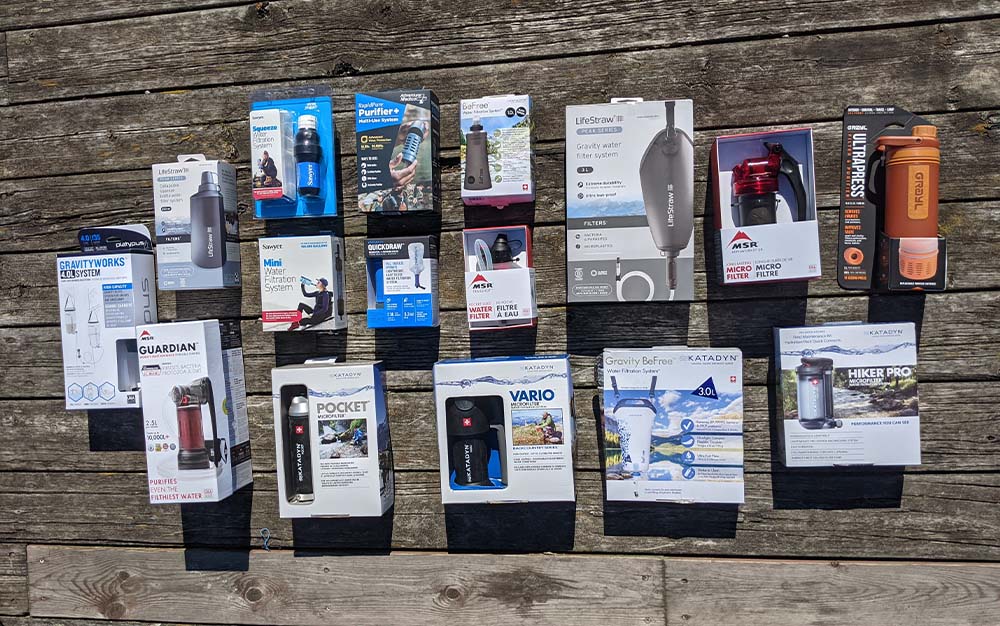
The initial field. Laura Lancaster
How I Tested Backpacking Water Filters
Before I even began testing, I interviewed the folks at MSR, LifeStraw, and Katadyn about how they guarantee that their filters are indeed removing bacteria and protozoa (and in the case of a few of them, viruses). All of them engage in rigorous testing, using EPA or NSF standards, both in their own facilities and through third parties, like BCS Laboratories out of Florida. I visited the MSR facility where they showed me the lab where they not only grow E. coli bacteria, but also a virus that attacks E. coli, to test the performance of their Guardian filter. The thoroughness of this testing is not something that can be easily replicated in the natural environment, where the pre-existing levels of bacteria, protozoa, and viruses are unknown. As such, my testing did not look at how well the filters dealt with bacteria, protozoa, and viruses, because all the filters in this review use EPA or NSF standards.
Something else that you’ll often see on the packaging of backpacking water filters is the number of liters per minute that they filter. This number, however, only reflects what the filter is capable of doing right out of the box—not after you’ve taken it out on a couple of backpacking trips—or 20. The brands of course are testing to ensure that the filters can withstand a certain level of grit, but it’s rare to learn what the flow rate of the filters is after they’ve been exposed to some less-than-ideal water sources, let alone how much grit and sediment and muck a filter can take before it craps out completely. So my testing looked at what conditions can the backpacking filters withstand and still return a reasonable (or any) flow rate.
To start, I called in or purchased the most popular backpacking water filters available, along with corresponding models from their competitors. Before I began testing the filters out in the field, I first timed how long it took each to filter one liter of water. Generally, these times corresponded to the advertised times of the manufacturers. During this process, I also noted how complicated the filter setup was out of the box.
Then I took the filters to was a public beach in Bellevue, Washington, which had been closed due to high levels of fecal matter (three times more than what’s considered safe for swimming).
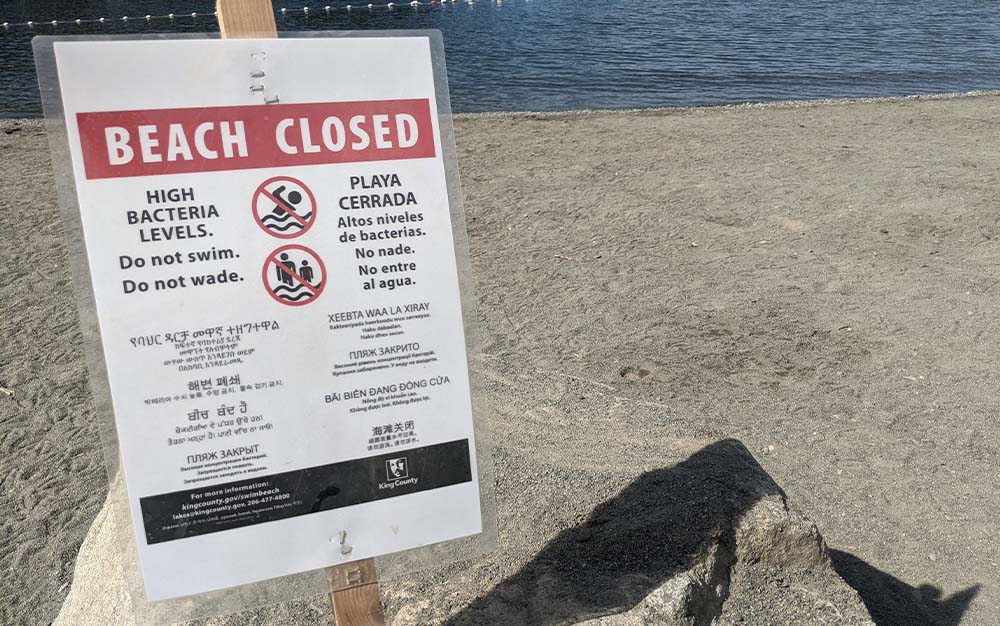
Bad news for swimmers; good news for filter testing. Laura Lancaster
In addition to the recorded high levels of fecal contamination, the water was also fairly scummy.
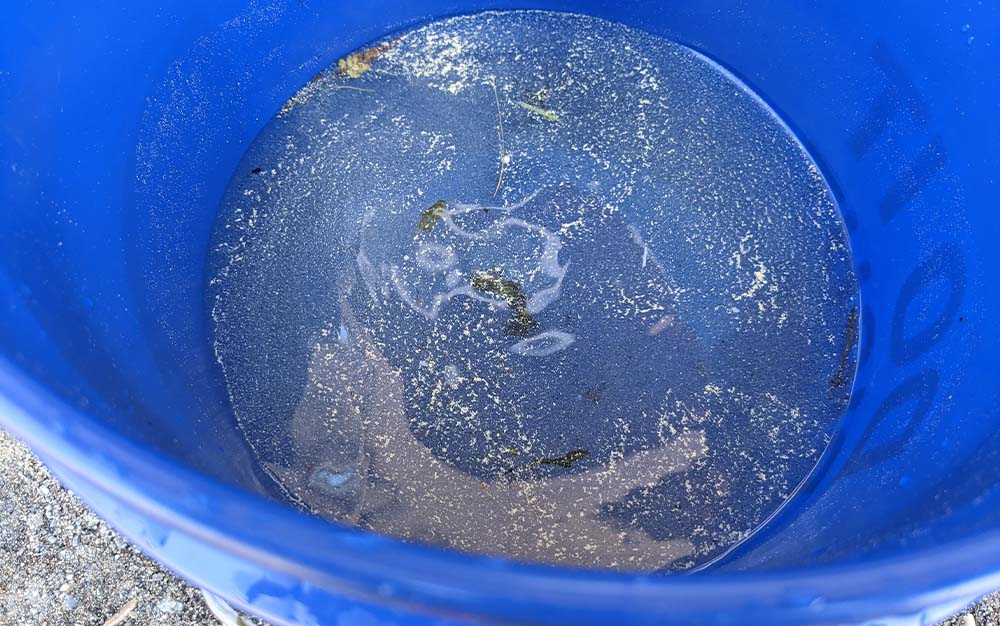
I wouldn’t want to drink that even without knowing that it was heavily contaminated with bacteria. Laura Lancaster
The results of this first round of testing informed the below recommendations. In the coming weeks, I’ll continue to test the water filters in two other environments: a wetland, with the classic tannin-colored water, and in the streams coming off of Mount Rainier, which are full (especially in the warm days of summer) of glacial silt. I’ll update this story after I complete each test.
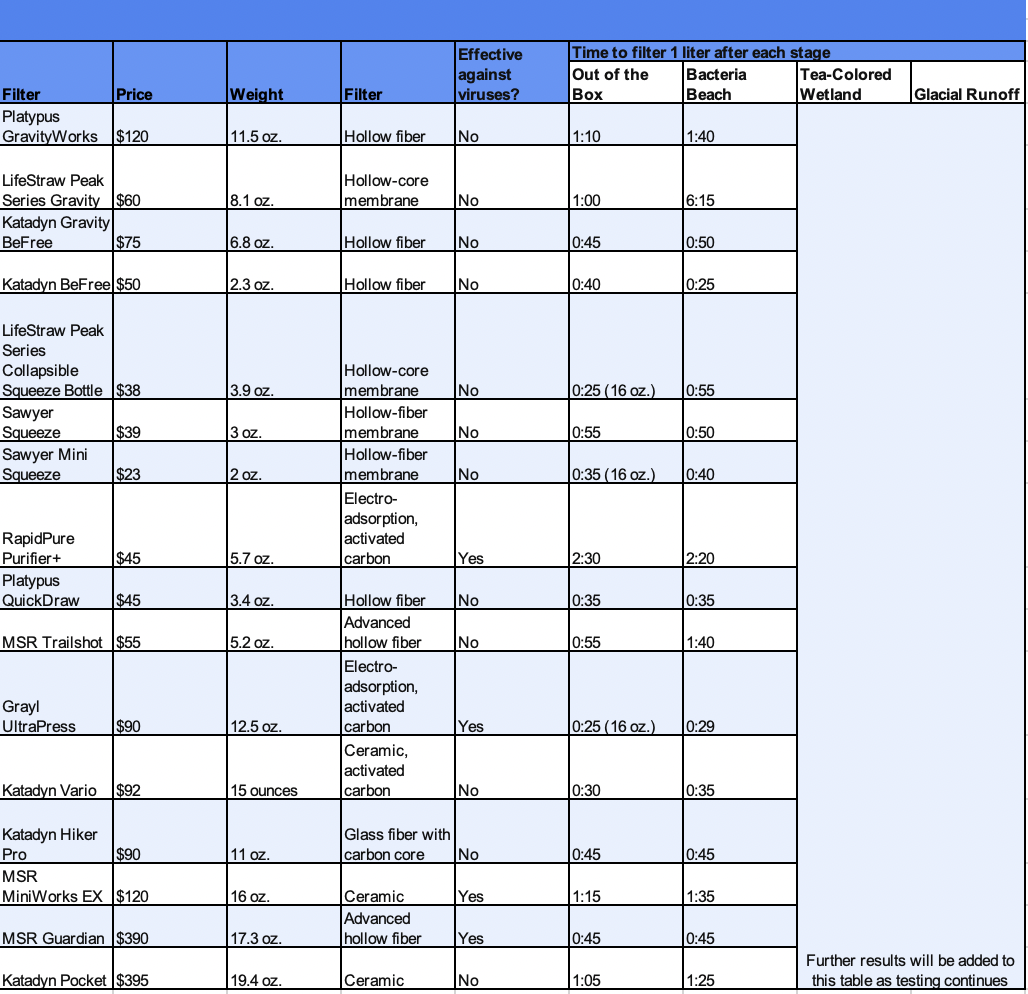
You’ll notice that some of the times to filter a liter of water appear to be faster after the first stage of testing than after the initial unboxing. That’s because the more you use each filter, the more efficient you become with it. As such, I’ve left those results as is.
Best Lightweight and Best Gravity: Katadyn BeFree and Katadyn Gravity BeFree
Key Features
- Effective against protozoa and bacteria
- Weight: 2.3 ounces (6.8 ounces for the gravity version)
- Filter Pore Size: .1 micron
Why It Made the Cut
After the first stage of testing, the lightweight Katadyn BeFree Water Filtration System had the fastest flow of any in my test, while the Katadyn BeFree Gravity had the fastest flow of the gravity filters.
Pros
- Filters water quickly
- Simple mechanism
- Lightweight
- Affordable
Cons
- Difficult to get the last of the water out of flask
- No ability to backflush
Product Description
At its core, all a water filtration system needs to do is move dirty water through a filter, without inadvertently contaminating the clean water vessel on the other side. One of the most popular styles of backpacking water filters leans into this simplicity: all a user has to do is fill up a plastic bag with dirty water, attach the filter, and then squeeze the water through into their drinking vessel.
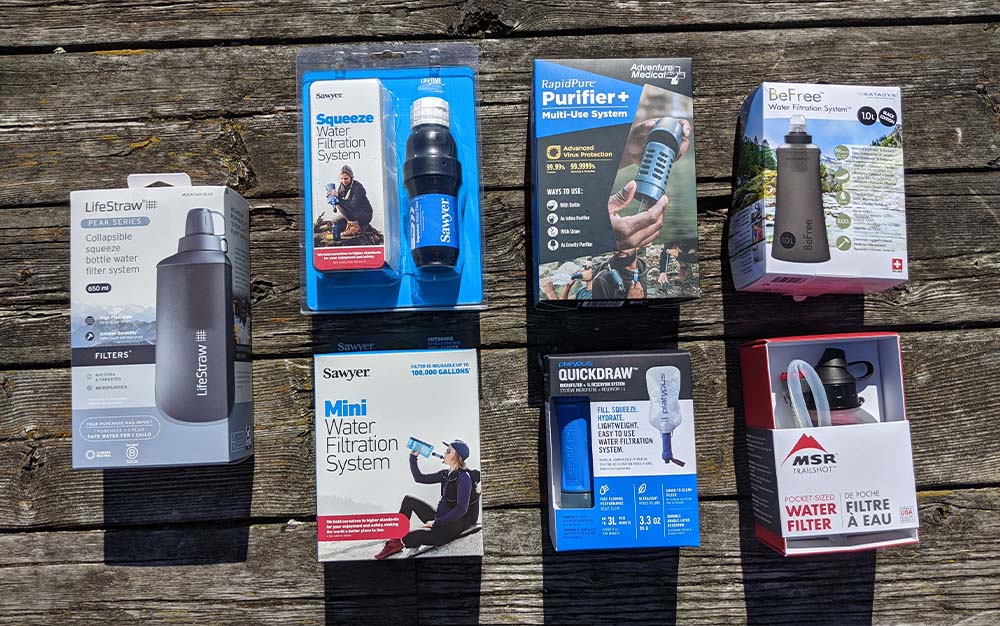
A number of brands make filters similar in function to the Katadyn BeFree. Laura Lancaster
In testing, the Katadyn BeFree had far and away the fastest flow rate of anything I tested—twice as fast as several other leading models. It was also impressively lightweight (although, like all water filters, expect the weight to go up a bit after the filter is saturated with water for the first time). Check and check.
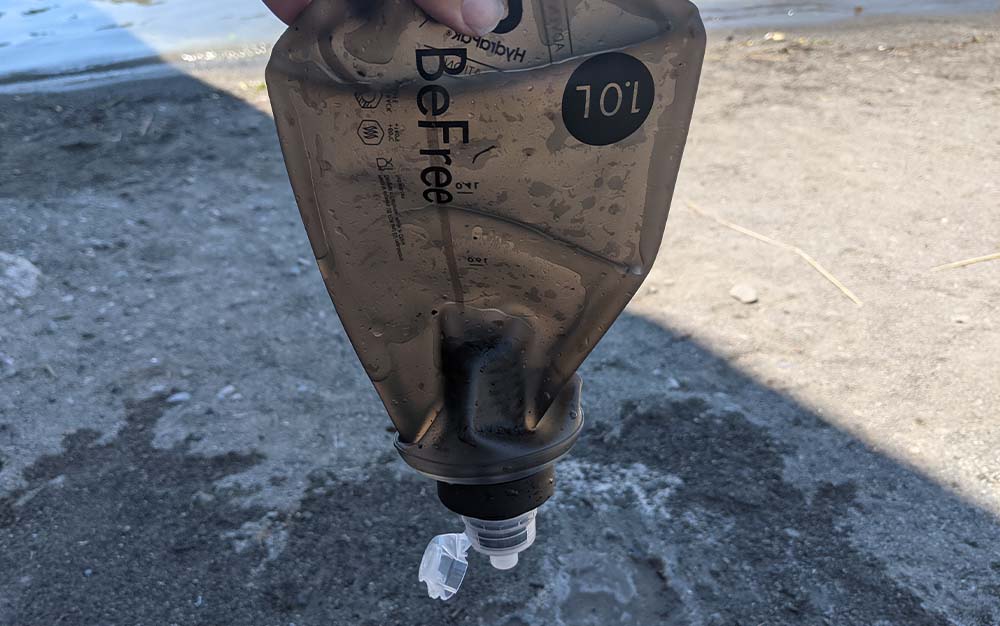
The flow rate out of the Katadyn BeFree was lightning fast, at least until I got to the last few drops. Laura Lancaster
There are a few design details, however, that I wish were different about the BeFree. The first, and biggest one, is the choice to house the filter itself inside the water flask. This made it difficult to squeeze all of the water inside of the flask out, which may be frustrating for individuals backpacking in parts of the country with difficult to access water sources. The other is the design of the lid cap, which basically resembles what you would see on a sports drink at the convenience store. When I lightly twisted it to test the durability it easily snapped off. Of course, I can still use the filter as long as I hold onto the cap, but I would rather see a more durable cap in exchange for a few extra grams.
Gravity BeFree
Similarly, the Katadyn Gravity BeFree had the fastest flow of the three gravity filters in my test, both when initially unboxed and after the first stage of testing. It was also lighter than the other two models in my test by several ounces.
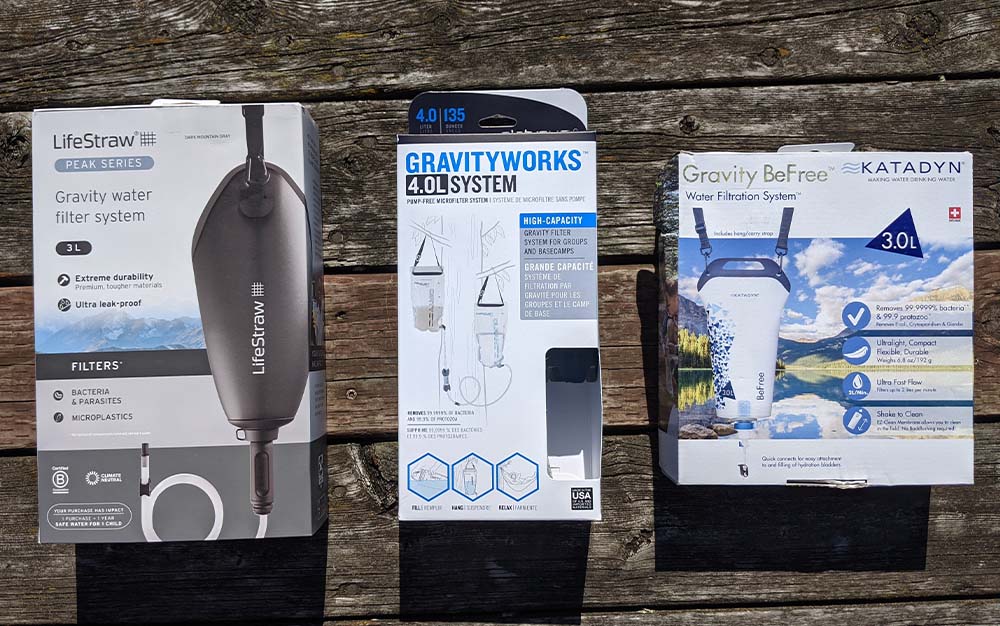
Three of the biggest brands in water filters—LifeStraw, Platypus, and Katadyn—all sell gravity filters. Laura Lancaster
One small, but potentially significant, difference between the Katadyn BeFree and the Platypus GravityWorks and LifeStraw Peak Series Gravity is that the hang strap is not attached to the water flask when the gravity is first unboxed. This strap, however, should not be considered optional. The bail handle at the top of the water flask is not intended to be slung over a branch, and is too small for the branch size that you would need for the filter to be safely suspended.
Another difference between the Katadyn Gravity BeFree and the other two filters in my test is that it is not designed for backflushing (which could damage the fibers), but the filter can be cleaned by carefully swishing it in water. I’lll be watching carefully to see if this impacts performance as testing continues.
Best Budget: Sawyer Squeeze Mini
Key Features
- Effective against protozoa and bacteria
- Weight: 1.4 ounces
- Filter Pore Size: .1 micron
Why It Made the Cut
The most affordable filter in my test had a completely respectable flow rate after the first round of testing.
Pros
- Very affordable
- Lightweight
- Filter can be screwed onto a standard 28mm water bottle (such as a smartwater bottle)
Cons
- Not the fastest flow
- Accompanying dirty water bag is only 16 ounces
Product Description
The Sawyer Squeeze systems have been popular among serious backpackers for years for two simple reasons: they are inexpensive, and they are versatile. While other similar squeeze systems (like the LifeStraw Peak Series and Katadyn BeFree) must be used with the bags or flasks that they came with, the Sawyer Squeeze (as well as the more expensive Platypus QuickDraw) can be screwed onto a standard 28mm water bottle, such as a smartwater bottle. Some backpackers will even just carry a single smartwater bottle filled with dirty water, and then drink straight from the filter.
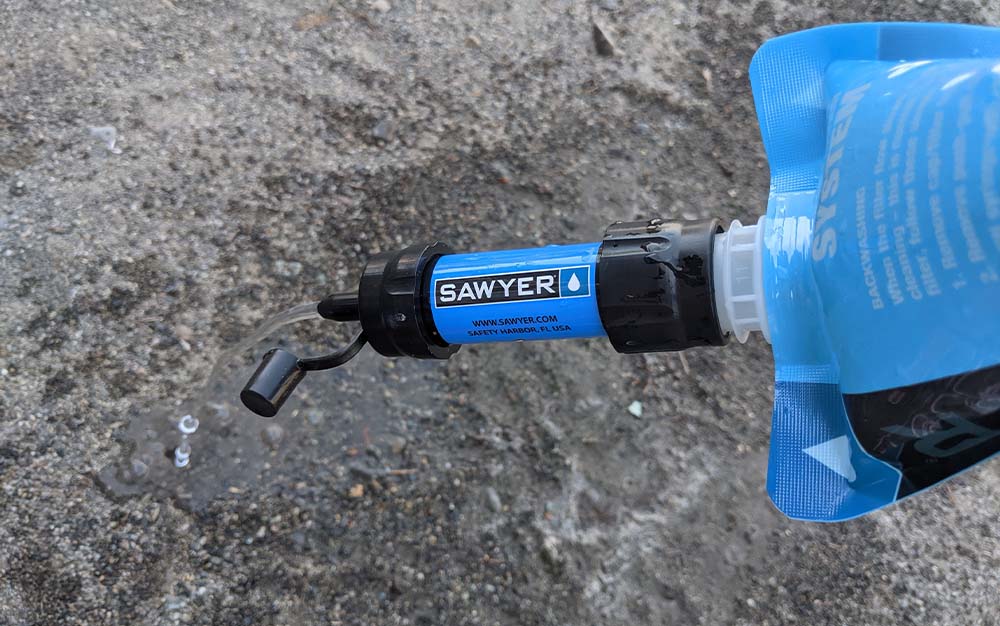
A little more elbow grease was required to get the flow going out of the Sawyer Mini. Laura Lancaster
I used the provided dirty bag during testing and was impressed with its durability. Even after squeezing the bag as hard as I could to push the water out over ten rounds of filling and filtering to reach the desired five liters, the bag still looked like new. I only wish that it was larger—the bag that comes with the mini is 16 ounces rather than the standard liter. Something else I noticed during testing was that the filter itself did not appear to screw onto the bag correctly. Each time I tried to fix it, the angle would still be lopsided. Fortunately, there were no leaks during testing so this appears to be mainly an aesthetic concern.
While the flow rate for the Sawyer Mini was not especially impressive (about four times as long as the Katadyn BeFree), I did appreciate that it came with a lightweight syringe to backflush the filter when it starts to clog too much.
Best for Groups: Platypus GravityWorks
Key Features
- Effective against protozoa and bacteria
- Weight: 11.5 ounces
- Filter Pore Size: .2 micron
Why It Made the Cut
The 8-liter capacity of the Platypus GravityWorks is one of the best backpacking water filters to ensure there is enough water at camp for larger groups.
Pros
- Largest capacity flasks of any filter in my test
- Easy to avoid cross-contamination
- Strong flow after the first round of testing
Cons
- Expensive compared to other gravity filters I tested
Product Description
Gravity filters have been growing in popularity due to the user’s ability to get up and walk away to handle other camp chores, or even just take a break on the trail, while gravity does the work of actually filtering your water.

Three of the biggest brands in water filters—LifeStraw, Platypus, and Katadyn—all sell gravity filters. Laura Lancaster
The idea behind a gravity filter is fairly straightforward, instead of squeezing or pumping dirty water into your drinking vessel, let gravity do the work for you. After filling up the dirty bag, you then elevate it by placing it on a large rock, hanging it in a tree, or even holding it yourself, whatever works. The higher the water is, the faster it will flow through the filter, but it will work as long as the bag itself is higher up than the end of the outlet hose. Then you can just walk away while gravity forces the water from the dirty water sources into your clean container.
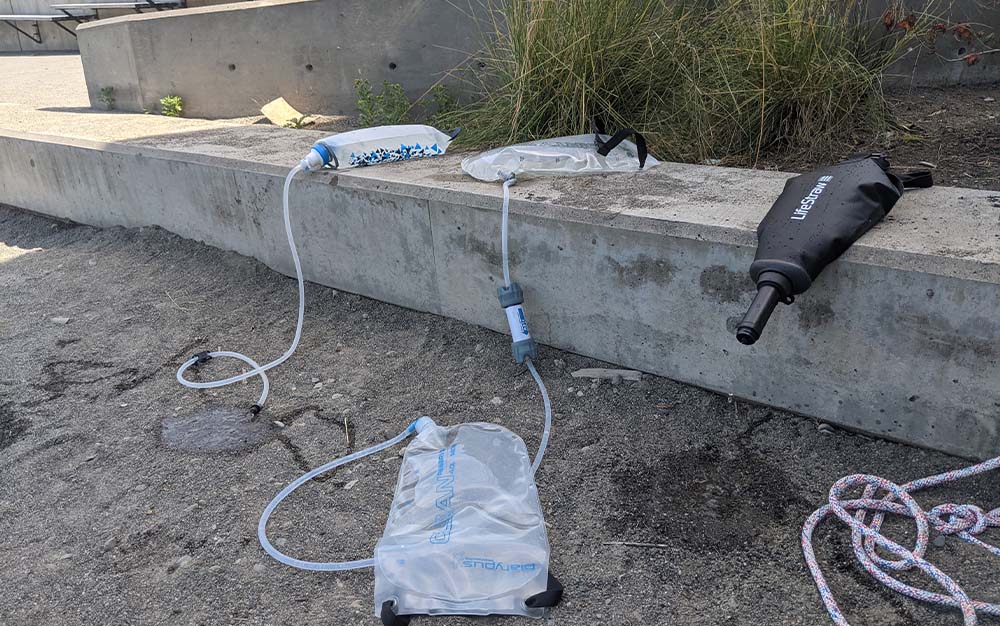
During testing, the filters all worked great even when only elevated a couple of feet off the ground. Laura Lancaster
All the gravity filters in my test came with a flask of at least three liters, which is nice if you are traveling with multiple people, as it reduces the number of rounds of filling up your dirty flask that you need to do. The Platypus GravityWorks takes this a step further, with a dirty flask capacity of four liters. Even better, it comes with a second bladder to filter your clean water directly into it.
In testing, the GravityWorks took about twice as long to filter a liter of water after the first stage of testing as the Katadyn BeFree. One other important difference with this filter, however, is that it can be backflushed, which will be completed after the second stage of testing to see what difference it makes in the flow rate.
Something else I liked about the Platypus Gravityworks is that it was relatively easy to avoid cross-contamination while out on the trail, even with all of the tubes and flasks. The clean flask is clearly labeled as such, so there is no risk of accidentally filling it with unfiltered water, and the the two tubes connecting the flasks to the filter have different connection points to the flasks, so there is no risk of connecting the wrong tube to the wrong flask.
Best Virus Protection: MSR Guardian
Key Features
- Effective against protozoa, bacteria, and viruses
- Weight: 17.3 ounces
- Filter Pore Size: .02 micron
Why It Made the Cut
Of the water filters that are effective against viruses, the MSR Guardian was by far the fastest.
Pros
- Effective against viruses in addition to protozoa and bacteria
- Respectable flow rate
- Backflushes the filter with each pump
- Can withstand freezing temperatures (assuming you let it thaw out afterward)
Cons
Product Description
For backpacking water filters, protection against viruses, including norovirus and rotovirus, comes with a tradeoff—if you want a filter with a small enough pore size to weed those suckers out, you better be prepared to put in some serious elbow grease. But the MSR Guardian manages the hat trick, filtering out viruses at a totally respectable flow rate with the same, or even less, elbow grease required from other filters.
Part of this due to a unique feature to the MSR Guardian: instead of directing all of the water out through the bottom of the filter with each pump, a portion of the water is directed back through the filter—essentially backflushing the filter with each pump. During testing, this meant that the filter had the same performance after the first round of testing as before.
I was also impressed with how easy the MSR Guardian was to use straight out of the box: after it had been unmoored from its packaging, I simply unscrewed the cap on the bottom of the filter, plopped the intake filter into my pool of water and started pumping away. If you’re looking for a no-brainer filter that can remove the full spectrum of bacteria, protozoa, and viruses from your water with basically no maintenance required, then this is the filter for you.
FAQs
Q: How much does a backpacking water filter cost?
Backpacking water filters can cost as little as $25 to as much as $400. Much of the difference in cost reflects the long-term durability of the filter, as well as their ability to handle more complex water quality problems, including viruses and heavy metals.
Q: Do I need a water purifier for backpacking?
The question of whether you need a water filter or purifier for backpacking is, to an extent, about the level of risk you are willing to tolerate. In the high alpine of a national park, for instance your odds are low, while if you are sharing a water source with livestock in a national forest, the odds increase considerably. Because the consequences of contracting a waterborne illness like giardia or cryptosporidium can be so severe, and both the cost and weight of low-profile filters like the Sawyer Mini Squeeze, Platypus Quickdraw, and LifeStraw Peak Series is not a burden for most backpackers, I recommend always carrying one in your hiking backpack and treating all your water sources with it. If you are unsure as to whether you need a water purifier—which will also remove viruses like rotovirus and norovirus—contact the land manager where you plan to travel for more information about the waterborne contaminants typically found there.
Q: Do I need to boil my water if I’m using a backpacking water filter?
Even today, it is fairly common to see a blanket recommendation to always boil your water when out in the backcountry. The reason for this is simple: most backpacking water filters do not remove viruses, whereas chemical treatment methods are not effective at neutralizing protozoa like giardia and cryptosporidium. Boiling water, on the other hand, does it all. The trouble with this recommendation is that boiling water is not only time consuming, but can also require you to bring in an excess of fuel or a backpacking stove if where you are traveling doesn’t have options readily available. Even if you do plan to boil all your water, carrying a lightweight filter is an important backup to have in the event that your fuel sources run out.
Things to Consider Before Buying Backpacking Water Filters
Filter versus Purifier
The difference between a water purifier and a water filter comes down to its filter pore size. Traditional water filters have pore sizes, typically .2 microns or 200 nanometers, that are small enough to weed out bacteria and protozoa, but not the much smaller viruses, such as rotovirus (70 nanometers) or norovirus (38 nanometers). Individuals traveling to backcountry environments known to be infected with viruses should take extra caution that their filter will protect them, but it is not common for water sources to be contaminated with viruses.
Camp versus Trail
If you plan to put a ton of miles on your hiking shoes, then the lighter weight of a squeeze-bag style filter may be a higher priority for you. However, if you are only hiking a short distance to camp, then the convenience of a gravity filter or the lower-effort pump filters may be an easier choice.
Sediment and Debris
If you expect the water sources on your next backpacking trip to be unusually dirty—full of swirling sediment or plant matter—then it’s best to choose a backpacking water filter with a prefilter. The prefilter helps to ensure that some of the muck in the water source doesn’t make its way into the more delicate fibers of your filter, which can ultimately clog it and render it inoperable.
Final Thoughts
The best backpacking water filters produced by reputable brands like MSR, LifeStraw, Katadyn, Platypus, RapidPure, and Grayl provide excellent protection against waterborne diseases in the backcountry. Which filter is right for you will depend in large part on whether you prioritize cost, weight, or long-term durability. While there are increasing numbers of low-profile filters on the market that are capable of removing viruses from water sources, during testing these were so arduous to use after even the first round of testing that I would recommend backpackers pair a chlorine-based disinfectant or even a UV-based purifier like a SteriPen with a water filter instead.
I will continue testing the backpacking water filters in this review in “tea” colored water at a wetland, as well as in glacial runoff to see how they handle even more challenging conditions.
The post The Best Backpacking Water Filters of 2022 appeared first on Outdoor Life.
By: Laura Lancaster
Title: The Best Backpacking Water Filters of 2022
Sourced From: www.outdoorlife.com/gear/best-backpacking-water-filters/
Published Date: Thu, 30 Jun 2022 22:21:34 +0000
----------------------------------------------
Did you miss our previous article...
https://manstuffnews.com/weekend-warriors/the-design-difference-the-new-sst-v6-kite
 Backyard GrillingWeekend WarriorsAdvice from DadBeard GroomingTV Shows for Guys4x4 Off-Road CarsMens FashionSports NewsAncient Archeology World NewsPrivacy PolicyTerms And Conditions
Backyard GrillingWeekend WarriorsAdvice from DadBeard GroomingTV Shows for Guys4x4 Off-Road CarsMens FashionSports NewsAncient Archeology World NewsPrivacy PolicyTerms And Conditions
